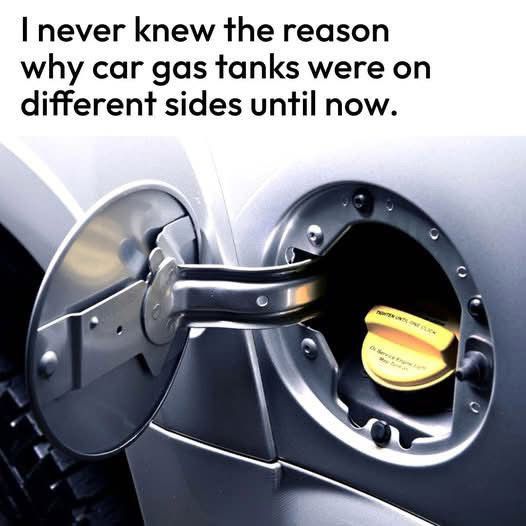If you’ve ever driven a variety of cars or visited a busy gas station, you’ve probably noticed that not all vehicles have their gas tanks on the same side. Some are on the left, others on the right, and for many drivers, this inconsistency can be a bit of an inconvenience—especially when trying to pull up to the correct side of the pump. While it may seem like a simple design oversight or even a random decision, the truth is that there’s a lot of careful planning and engineering that goes into determining where a gas tank should be placed on a car. Automakers consider several factors—ranging from performance and safety to manufacturing efficiency and driver convenience—when deciding which side the fuel door will be located on.

One of the biggest influences on fuel tank placement is vehicle design and weight distribution. Engineers strive to create balance within the car to improve handling and stability. For instance, if a car’s engine is offset or there are heavier mechanical components on one side of the vehicle, placing the gas tank on the opposite side can help balance the overall weight. Achieving this kind of symmetry allows for better control while driving, especially when the fuel tank is full and adds significant weight to the vehicle. Even a small shift in weight distribution can affect how a car performs on the road, which is why engineers take this aspect seriously.
In addition to weight distribution, the internal layout of the car also plays a major role. Vehicles are built with a complex system of mechanical and electrical components, and each one has to fit in harmony without interfering with another. The placement of fuel lines, exhaust systems, and suspension parts often limits where the gas tank can be safely and efficiently installed. Automakers must work within these constraints, ensuring that the fuel system operates properly without compromising the design or functionality of other parts of the car. It’s a puzzle that engineers solve with precision, and sometimes the result means placing the gas tank on the left, and other times on the right.
Safety regulations are another key consideration in the placement of gas tanks. Cars must meet strict crash safety standards, and part of that includes protecting the fuel system from impact during collisions. By strategically placing the fuel tank away from crumple zones or high-impact areas, automakers reduce the risk of fuel leakage or fires in the event of an accident. Depending on the car’s frame, structure, and design, the safest location for the gas tank might be on either side. Safety testing helps determine the most secure option for each model.
Production and manufacturing efficiency also factor into the decision. Vehicles are built on assembly lines with parts being added in a specific sequence. The location of the gas tank can be influenced by how easily it can be installed during production or serviced later on during maintenance. Manufacturers are always looking for ways to streamline the assembly process and reduce costs, so a fuel tank’s placement could come down to making the build quicker or less expensive without sacrificing performance or safety.
While it may not be the most critical reason, driver convenience is also part of the equation. Some automakers consider which side of the vehicle will be more accessible for the driver when pulling up to a gas station. For example, placing the gas cap on the driver’s side may save time and make refueling more straightforward. Still, this varies by brand and model, and in most cases, it’s not the top priority. In regions where cars drive on the right-hand side of the road, some manufacturers may place the fuel door on the right for convenience, but there’s no global standard that dictates this.
Ultimately, when you drive a new or unfamiliar car, it’s always smart to check the fuel gauge—most cars include a small arrow next to the fuel icon that shows which side the gas tank is on. This tiny detail helps avoid confusion and wasted time at the pump. The variation in fuel tank placement isn’t arbitrary; it’s the result of detailed engineering, safety standards, and design optimization. So the next time you pull up to the gas station and realize your tank is on the “wrong” side, remember it’s not a mistake—it’s a carefully considered choice made by the people who built your car.





